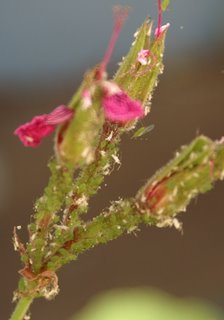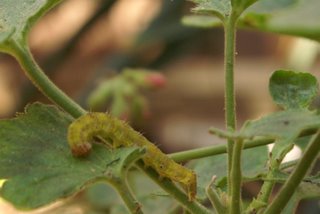
Some plants attract woes like compost draws in green peach beetle grubs. This poor little pelargonium seems to be growing nicely until one day a few aphids showed up. In about a week the entire plant is covered in aphids, their shed exoskeletons, and honeydew.
Then a caterpillar materializes and chews up the leaves that don't have any aphids on them.

Then sooty mold starts growing on the leaves covered with honeydew.

Just for good measure a katydid nymph (haven't seen any of them on any other plants lately) emerges, to disfigure the flowers. It's been observed that plant eating insects detect chemical markers given off by plants under stress, in an evolutionary development not unlike the way bullies instinctively single out the kid least likely to fight back. So if one's pelargonium has called its own troubles down on it due to str
 ess, one must wonder (and worry about) what one has done to cause stress on one's pelargonium; and, how can one alleviate said stress. Or at least how can one teach one's pelargonium to box.
ess, one must wonder (and worry about) what one has done to cause stress on one's pelargonium; and, how can one alleviate said stress. Or at least how can one teach one's pelargonium to box.
3 comments:
"It's been observed that plant eating insects detect chemical markers given off by plants under stress, in an evolutionary development not unlike the way bullies instinctively single out the kid least likely to fight back."
I don't understand this bit.
With animals, fighting back is something that an individual can do better or worse. A sick antelope is less able to inflict injury on a lioness than a healthy one, which is a strong evolutionary incentive to the lion to learn how to distinguish them.
Also, with animals there is lots of running and chasing involved. It's to the lion's benefit to chase the slowest antelope.
But I don't see how this applies to plants. What is the predator gaining by going after a sick plant?
Well, the titanic struggle between phytophagous insects and plants is a lot less exciting than the drama in the mammalian world, that's for sure. Plants fend off infestation in quiet ways, like by producting sap. Healthy sap flow, esp. in woody plants and trees, keeps plant tissue from being invaded by insects. Less healthy plants produce weaker sap flow so are easier to invade; and they heal slower which then permits more infestation. Other ways plants defend against insect attacks are by producing toxins, waxy exudates, and spines. Stressed plants have less energy to produce these, allowing insects to get a relatively stronger foothold. Another basic and very quiet defense is to outgrow the infestation. As the plant tissue matures, it's less vulnerable to insect exploitation (thicker cell walls for ex.) Weak, stressed plants grow slower, and may fall into a downward cascade due to energy lost to successive infestations. A lot of times, though, a plant does not die; it just gives up a bit or a lot of its energy to the insects.
In a nutshell, insects spend less energy getting food by infesting a weaker plant; and that gives them an advantage because they might mature a generation of offspring sooner, or their offspring might be more numerous, or stronger. The advantage they get must be good enough to offset the expense of having developed the ability to detect the plant's weakness. And, most insects' life cycles are short enough so the demise of the host plant isn't catastrophic to the next generation. Sure the value of the plant as food declines as it's condition worsens, but the insects may already be maturing into flying adults (which often use an entirely different food source) or they may be mobile enough as larvae or nymphs to move onto new more useful plants.
Thomas Eisner's book "For Love of Insects" has a lot of info on the chemical and physical relationships between plants and animals as well as really great macro photos.
At least, that's what I've noticed when I'm kicking around in the garden and esp. commercial landscapes where the environment isn't so nicely balanced.
Post a Comment